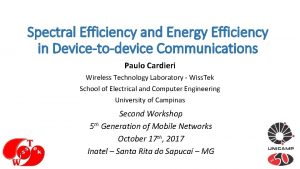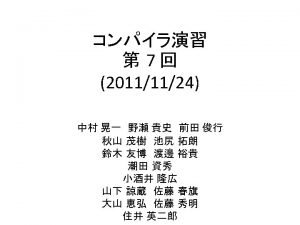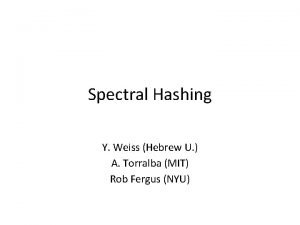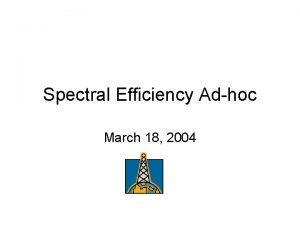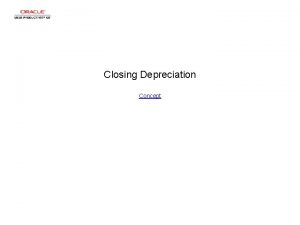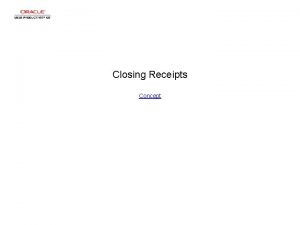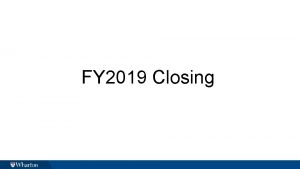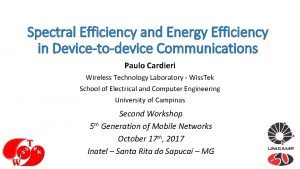Spectral Efficiency Adhoc Closing Report March 18 2004







- Slides: 7

Spectral Efficiency Ad-hoc Closing Report March 18, 2004

Closing Report of SE Ad-hoc • The ad-hoc group did not reach consensus on a single option but is recommending two options for further consideration by the Working Group. – A modification of Option 1 (referred to as Option 1 b) which more explicit explanation of how the values in the table are to be interpreted. – Option 3 with a proposed correction to one of the values • There was also discussion on the ramifications of mandatory requirements. – One interpretation is that all mandatory requirements must be met be the final standard and if this is not feasible the requirements document will have to be revised. – An alternate interpretation was that as long as the final standard did not violate the effective PAR, the requirements document would not require revision.

Option 1 b The system spectral efficiency of the 802. 20 air interface shall be quoted for the case of a three sector baseline configuration[1]. It shall be computed in a loaded multi-cellular network setting, which shall be simulated based on the methodology established by the 802. 20 evaluation criteria group. It shall consider among other factors a minimum expected data rate/user and/or other fairness criteria, and percentage of throughput due to duplicated information flow. The simulations shall be run with the following three mobility classes, 3 km/h, 120 km/hand 250 km/h. The values shall be quoted on a b/s/Hz/sector basis. The weighted average of the spectral efficiency shall be computed by multiplying the spectral efficiency at 3 km/h by x, the spectral efficiency at 120 km/h by y, and spectral efficiency at 250 km/h by z. (Where x, y, z > 0 and x+y+z=1). [values TBD e. g. x=. 4, y=. 5, z=. 1] The weighted average system spectral efficiency of the 802. 20 air interface shall be greater than:

Option 1 b Parameter Spectral Efficiency Requirements and Targets Downlink Spectral Efficiency (b/s/Hz/sector) Uplink Required Minimum Desirable Target 1. 2 2. 4 0. 6 1. 2 The spectral efficiency at different mobility speeds should degrade gracefully. [1]Since the base configuration is only required for the purpose of comparing system spectral efficiency, proposals may submit deployment models over and beyond the base configuration.

Option 3 In this document, the term “System Spectral Efficiency” is defined in the context of a full block assignment deployment and is, thus, calculated as the average aggregate throughput per sector (bps/sector), divided by the spectrum block assignment size (Hz)( taking out all PHY/MAC overhead). For proposal evaluation purposes, the System Spectral Efficiency of the 802. 20 air interface shall be quoted for the case of a three sector baseline configuration[1] and an agreed-upon block assignment size. It shall be computed in a loaded multi-cellular network setting, which shall be simulated based on the methodology established by the 802. 20 evaluation criteria group. It shall consider, among other factors, a minimum expected data rate/user and/or other fairness criteria, Qo. S and percentage of throughput due to duplicated information flow. [1]Since the base configuration is only required for the purpose of comparing system spectral efficiency, proposals may submit deployment models over and beyond the base configuration.

Option 3 The system spectral efficiency of the 802. 20 air interface shall be greater than the values indicated in table 4 -1. The spectral efficiency at higher speeds than those shown should degrade gracefully. Channel Bandwidth Parameter 1. 25 MHz. @ 3 km/hr 1. 25 MHz. @ 120 km/hr 5 MHz. @ 3 km/hr 5 MHz. @ 120 km/hr DL UL 2. 0 1. 0 0. 75 Spectral Efficiency (b/s/Hz/sector)

Option 3 m (Proposed simplification of table and correction) The system spectral efficiency of the 802. 20 air interface shall be greater than the values indicated in table 4 -1. The spectral efficiency at higher speeds than those shown should degrade gracefully. Parameter Spectral Efficiency Requirements and Targets Downlink Spectral Efficiency (b/s/Hz/sector) Uplink 3 km/hr 120 km/hr 2. 0 1. 0 (1. 5) 1. 0 0. 75 (correction proposed)
